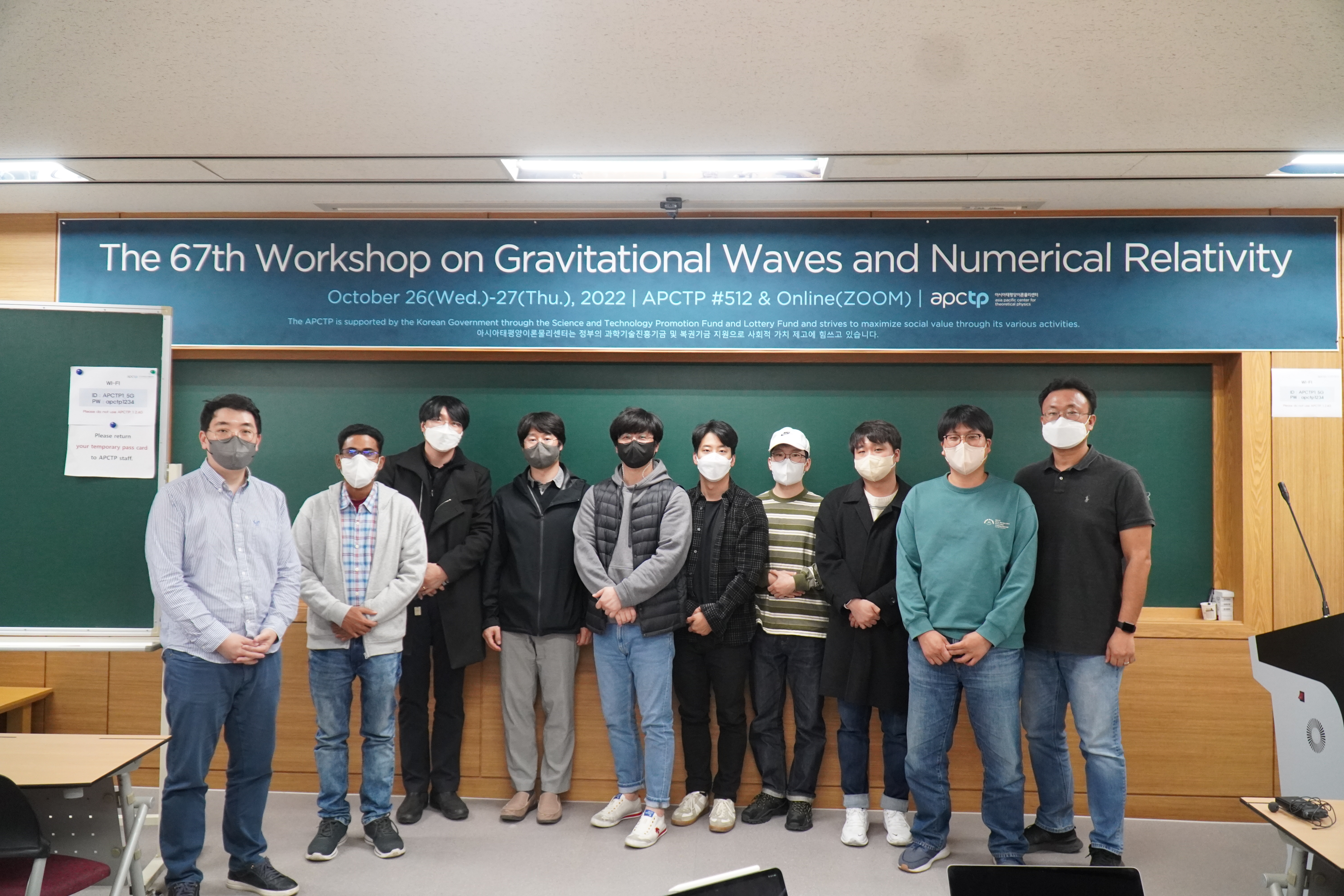Information
- Date: Oct. 26 (Wed.) - Oct. 27 (Thu.), 2022
- Venue: Rm #512, APCTP / Online (Hybrid)
- Audience: Researchers and students in astrophysics
- Number of participants: 15 Offline / 15 Online
- Format: Long and intensive sessions from basic lecture to the latest research with a comfortable atmosphere to ask questions and discuss freely
- Sponsor: APCTP
- Contact
- Chan Park: iamparkchan at gmail dot com
- Jinho Kim: jkim at kasi dot re dot kr
Program
- Time zone: Korea Standard Time (UTC+09:00)
- Oct. 26 (Wed.)
- 14:00 - 14:25 [Student Session 1] Unveiling Impacts of Dynamical Effects on the Compact Binaries in Globular Clusters (Kwangmin Oh / CNU)
- 14:30 - 16:30 [Main Session 1] Ultra-High Energy Cosmic Rays Observed by the Telescope Array Experiment (Jihyun Kim / University of Utah)
- 16:30 - 18:00 Discussion
- Oct. 27 (Thu.)
- 10:00 - 10:25 [Student Session 2] Numerical Relativity Surrogate Model (Jooheon Yoo / Cornell University)
- 10:30 - 12:30 [Main Session 2] Gravitational Lensing of Gravitational Waves (Han Gil Choi / SNU)
Sessions
- Ultra-High Energy Cosmic Rays Observed by the Telescope Array Experiment
- Speaker: Jihyun Kim (University of Utah)
- Time: Oct. 26 (Wed.) 14:30 - 16:30
- Speaking Language: English
- Slide Language: English
- Abstract: Ultra-high energy cosmic rays (UHECRs) are energetic charged particles with E > 10^18 eV that impinge on Earth’s atmosphere from outer space. Their energies are much higher than those scientists can accelerate in the lab. By exploring the nature and origin of UHECRs, we hope to better understand where they are coming from and how they achieve such high energy, thereby giving us a window to understanding the universe. The Cosmic Ray Physics Group in the Department of Physics and Astronomy hosts the Telescope Array (TA) experiment in Delta, Utah, which is the largest observatory for UHECRs in the northern hemisphere. In this presentation, I will introduce the experiment and the findings of the TA. I will mainly focus on anisotropies in arrival direction distributions of UHECRs, which is critical to narrowing down source candidates.
- Slide File: Kim
- Gravitational Lensing of Gravitational Waves
- Speaker: Han Gil Choi (SNU)
- Time: Oct. 27 (Thu.) 10:30 - 12:30
- Speaking Language: Korean
- Slide Language: English
- Abstract: I will briefly review basics of gravitational lensing (GL). I will also highlight the distinguished features of lensing of gravitational waves (GWs) compared to lensing of electromagnetic sources by introducing recent research topics on GL of GWs. Lastly, I will introduce my work on how to probe the small scale structures of dark matter distribution using the wave optics nature of GL of GWs.
- Slide File: Choi
- Unveiling Impacts of Dynamical Effects on the Compact Binaries in Globular Clusters
- Speaker: Kwangmin Oh (CNU)
- Time: Oct. 26 (Wed.) 14:00 - 14:25
- Speaking Language: English
- Slide Language: English
- Abstract: Dynamical interactions in globular clusters (GCs) result in efficient production of the compact binaries (e.g. cataclysmic variable (CV), millisecond pulsar (MSP), quiescent low-mass X-ray binary (qLMXB) and black hole). On the other hand, the evolution of compact binaries plays a crucial role in determining the stability of GCs and how they evolve. For investigating such symbiotic relation, we have performed Monte Carlo simulations (MOnte-Carlo Cluster simulAtor : MOCCA) to explore how the dynamical interactions affect the formation of compact binaries and the populations of X-ray binaries. We have also examined the possible impact of such processes on the cluster structure.
- Slide File: Oh
- Numerical Relativity Surrogate Model
- Speaker: Jooheon Yoo (Cornell University)
- Time: Oct. 27 (Thu.) 10:00 - 10:25
- Speaking Language: English
- Slide Language: English
- Abstract: Analysis of gravitational wave (GW) detections requires accurate and reliable GW templates. Although Numerical Relativity (NR) provides accurate GW template, simulations are prohibitively expensive for direct GW data analysis applications. The need for a faster alternative to NR has led to the development of several semi-analytical waveform models. NR surrogate model takes a data-driven approach by training the model directly on NR simulations. In this talk, I will briefly overview NR surrogate models and talk about my recent work on the large-mass ratio surrogate model, NRHybSur2d15.
- Slide File: Yoo
Supports
- Accommodation
- 1 night 2 days (Oct. 26 - Oct. 27)
- Location: PIC
- Meals
- Dinner on Oct. 26
- Breakfast on Oct. 27
Registration
- Link: Google Form
- Due
- Accommodation support or reservation is required: Oct. 11 (Tue.)
- Online participation or no accommodation: Oct. 25 (Tue.)
Photos



